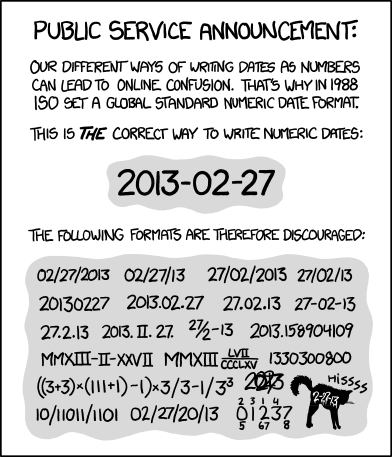
What do you mean you don’t use ISO 8601?
As researchers, we’re no strangers to the complexities of data management, especially when it comes to handling date and time information. Whether you’re conducting experiments, analyzing trends, or collaborating on projects, accurate temporal data is crucial. Like in many other fields, precision is key, and one powerful tool at our disposal for managing temporal data is the ISO 8601.
Understanding ISO Date and Time
ISO 8601, the international standard for representing dates and times, provides a unified format that is recognized and utilized across various disciplines. At its core, ISO date and time formatting adheres to a logical and consistent structure, making it ideal for storing and exchanging temporal data.
In the ISO 8601 format:
- Dates are represented as YYYY-MM-DD, where YYYY denotes the year, MM represents the month, and DD signifies the day.
- Times are expressed as HH:MM:SS, with HH denoting hours in a 24-hour format, MM representing minutes, and SS indicating seconds.
- Timezones are expressed with the letter “Z” to indicate UTC (Coordinated Universal Time) or “Zulu” time. Also, the format ±HH:MM represents the time zone offset from UTC, where the plus sign (+) indicates east of UTC, and the minus sign (-) indicates west of UTC. HH represents the number of hours, and MM represents the number of minutes offset from UTC.
Altogether, ISO 8601 allows for a comprehensive framework for managing temporal information with precision and clarity. For example:
- Date Only:
- January 15, 2024 is represented as: 2024-01-15
- December 3, 2022 is represented as: 2022-12-03
- Date and Time:
- February 20, 2024, at 09:30 AM is represented as: 2024-02-20T09:30:00
- November 10, 2022, at 15:45 (3:45 PM) is represented as: 2022-11-10T15:45:00
- Date, Time, and Timezone:
- August 8, 2023, at 14:20 (2:20 PM) in Eastern Standard Time (EST) is represented as: 2023-08-08T14:20:00-05:00
- March 25, 2022, at 10:00 (10:00 AM) in Coordinated Universal Time (UTC) is represented as: 2022-03-25T10:00:00Z
Advantages of ISO Date and Time
- Universal Compatibility: ISO 8601 is recognized globally, ensuring compatibility across different systems, software, and programming languages. This universality streamlines data exchange and collaboration among researchers worldwide.
- Clarity and Readability: The structured nature of ISO date and time formatting enhances readability and reduces ambiguity. This clarity is invaluable when communicating temporal information within research papers, datasets, and academic publications.
- Ease of Sorting and Comparison: ISO date and time formats lend themselves well to sorting and comparison operations. Whether organizing datasets chronologically or conducting temporal analyses, researchers can leverage ISO formatting to streamline data manipulation tasks.
Best Practices for Working with ISO Date and Time
- Consistency is Key: Maintain consistency in the use of ISO 8601 formatting throughout your research projects. Adhering to a standardized format enhances data integrity and simplifies data management processes.
- Document Time Zone Information: When working with temporal data across different time zones, document time zone information explicitly. This ensures accuracy and mitigates potential confusion or errors during data analysis.
- Utilize Libraries and Tools: Leverage programming libraries and tools that support ISO date and time manipulation. Popular languages such as Python and R offer robust libraries for parsing, formatting, and performing calculations with ISO 8601 dates and times.
- Validate Input Data: Prior to analysis, validate input data to ensure conformity with ISO 8601 standards. Implement data validation procedures to detect and rectify any inconsistencies or discrepancies in temporal representations.
Working with Date and Time in R and Python
Using R for Date and Time Manipulation
R provides powerful libraries like lubridate from the tidyverse for easy and intuitive date and time manipulation. With functions like ymd_hms() and with_tz(), parsing and converting date-time strings to different time zones is straightforward. Additionally, R offers extensive support for extracting and manipulating various components of date-time objects.
For code examples in R, refer to this code snippet on GitHub.
Using Python for Date and Time Manipulation
Python’s datetime and pytz modules offers comprehensive functionalities for handling date and time operations. Parsing datetime strings and converting timezones can be achieved using fromisoformat() and astimezone() methods. Python also allows for arithmetic operations on datetime objects using timedelta.
For code examples in Python, refer to this code snippet on GitHub.
Conclusion
When it comes to accurate research data, effective management of temporal data is indispensable for conducting rigorous analyses and drawing meaningful conclusions. By embracing the ISO 8601 standard for date and time representation, researchers can harness the power of standardized formatting to ensure data FAIRness.
Written by Lucas Alcantara
Comic’s Source: https://xkcd.com/1179



